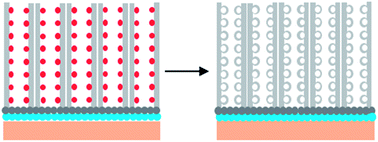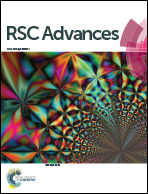Increasing the surface area of TiO2 nanotube membranes by filling the channels with onion type carbon materials and TiCl4 for dye-sensitized solar cells
Abstract
We have significantly enhanced the power conversion efficiency of dye-sensitized solar cells based on TiO2 nanotube membranes by increasing the inner surface area of the channels. Onion type carbon materials (OTCMs) were produced by injecting ethylene gas continuously into the Ar plasma of a thermal plasma system. The average size was about 20 nm. OTCMs were functionalized by treatment with sulfuric and nitric acids. Functionalized OTCMs were chemisorbed on the inner surface of the channels by spontaneous diffusion. To maximize filling, we vacuum-filled functionalized OTCMs and TiCl4 into the channels of TiO2 nanotube membranes in sequence, and then sintered at 500 °C. When being sintered, TiCl4 transformed to TiO2, while the carbon materials burnt. By filling OTCMs and TiCl4 in sequence and sintering, the inner surface became very rough, and the amount of dye adsorbed on the photoanode was increased about 50%. The electron lifetime and effective carrier diffusion length were increased by filling with functionalized OTCMs and TiCl4 in sequence. The power conversion efficiency of the DSSC based on TiO2 nanotube membranes was improved from 6.99 to 9.33%, a 33.5% enhancement. The efficiency enhancement is mainly due to an increase in the total available surface area for dye adsorption.


 Please wait while we load your content...
Please wait while we load your content...